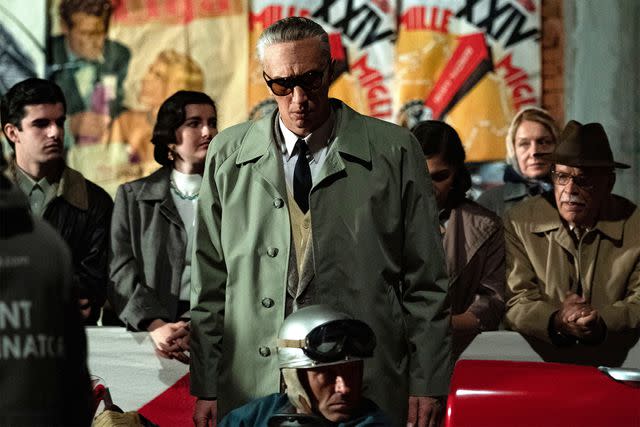“Ferrari” review: Adam Driver scowls through biopic that can’t get off the starting line
- Oops!Something went wrong.Please try again later.
- Oops!Something went wrong.Please try again later.
- Oops!Something went wrong.Please try again later.
- Oops!Something went wrong.Please try again later.
The latest from director Michael Mann is a weak entry in this year's buzzy biopics.
Of all this year’s “great man” biopics (Oppenheimer, Maestro), Ferrari is the most traditional. It’s also the least interesting.
Set in 1957, the film follows Enzo Ferrari (Adam Driver) as he struggles with his imploding marriage, his unacknowledged illegitimate son, and his company's impending bankruptcy. In an attempt to rally, he enters his racing team in the Mille Miglia with catastrophic results.

Everett Collection
Adam Driver in 'Ferrari'
Ferrari cannot decide whether it wants to be a movie about racing or a movie about a man. That is, at least, somewhat by design, given Ferrari’s single-minded obsession with his work and his repeated insistence that his company does not race to sell cars, but rather sells cars to be able to race. But while we understand that Ferrari loves the art, the risk, and the danger of racing, we never truly know why. It’s a surface-level interrogation of a man, one who wants us to see him as enigmatic but instead makes him infuriatingly inscrutable. Driver puts his all into the famously reserved figure, but he’s better served in projects that allow his simmering-beneath-the-surface emotions to explode, such as Marriage Story or, hell, even Star Wars.
The thing about Ferrari is that it feels like a biopic made during the studio era. As a lover of the Golden Age of Hollywood, I do not, sadly, mean that as a compliment. The dialect work ranks up there with House of Gucci as some of the most egregious in a movie in recent memory, with the vast majority of the cast slipping in and out of their Italian accents or, worse, sounding like they taught themselves by listening to Walt Disney's Pinocchio (1940). One of the worst offenders is Patrick Dempsey as driver Piero Taruffi, whose casting is at least a fun Easter egg given Dempsey’s own connections to the motorsports world. The only person who sounds believably Italian is Penelope Cruz as Ferrari’s wife Laura, and that’s because it’s a slight variation on her normal speaking voice.

NEON
Penelope Cruz in 'Ferrari'Cruz is, in fact, one of the only reasons for watching the movie. As Laura, she’s an exposed nerve of hurt, a wife drowning in the throes of grieving her lost child. But it’s not only her son, Dino, who she’s lost — it’s her husband too; Enzo has turned his attention to his business and his longtime mistress, Lina Lardi (Shailene Woodley), and their son, Piero (Giuseppe Festinese). But Cruz makes Laura so much more than a long-suffering wife; she’s also Enzo’s business partner and a woman with a fire in her belly that perhaps exceeds even her husband’s ambition. Cruz bites into the role with a visceral ferocity — her grief, her cunning, her intelligence, her jealousy, and her desire hurdling out of her with the volume turned all the way up. In Cruz’s hands, Laura is hungry, nearly starving — and she devours anyone and anything in her path.
Perhaps the most miscast member of the ensemble is Woodley. For at least half of the movie, it’s impossible not to wonder if Lina is an American ex-pat or an Italian, given that the accent work is so inconsistent. Beyond that surface-level assessment, however, Woodley feels decidedly too modern to fit into the world of post-war Italy. Some actors simply have no business in a period piece — everything about their state of being, their persona, and the way they move feels utterly contemporary. Woodley is one of these actors and, as such, feels distinctly out of step amidst the rest of the cast.

NEON
Shailene Woodley in 'Ferrari'That being said, except for the retro design of the cars and the presence of midcentury starlet Linda Christian (Sarah Gadon), there is nothing in Ferrari to indicate that it’s 1957 (besides a title card that telegraphs that information). Ferrari almost exclusively wears his signature gray suit, and there is little in either costuming or production design to situate us in this time and place. The film's design is not inaccurate but it is nondescript, so non-distinct to be distracting in its absence of a point of view.
It’s a strange misstep for director Michael Mann, a creative who practically invented cinematic style on television as the shepherd of Miami Vice and has continued to excel in that arena as the director of films including Thief, Manhunter, and Collateral. In contrast to those works, Ferrari feels bizarrely dull and unimaginative in its approach to its visual world.

The only place the movie actually kicks into gear is in the racing sequences. Mann has a fascination with depicting automobiles on screen, making them key parts of many of his titles as writer, director, and producer. But here, he gets to let loose, following drivers through the winding hills and cobblestone streets of the Mille Miglia’s public road course. There’s a palpable energy to these scenes that is lacking in the domestic and professional drama that dominates the first half of the film. The way the lens tracks the sleek lines of the cars as they make hairpin turns, the sense of fearlessness of the drivers as they volley for the lead, and the beauty of the countryside is invigorating. Even the race’s apex, a traumatic twisting of flesh and metal as a crash takes out not just the driver and navigator, but also nine observers, is balletic in its horrors.
But this is what I mean when I liken Ferrari to a studio-era biopic. Its interrogation of the man at its center is flattened, giving us only one insight into him — his unrelenting obsession with his “deadly passion.” Perhaps that is truly all there was to the real Enzo Ferrari; the film’s anecdote of a reporter labeling him a Saturn devouring his racers is a true one. The film does not valorize Ferrari, but it doesn’t complicate him either. And while its racing sequences are exhilarating, it should have spent more time looking under the hood. Grade: C-
Want more movie news? Sign up for Entertainment Weekly's free newsletter to get the latest trailers, celebrity interviews, film reviews, and more.
Related content:
Michael Mann promises 'the Gucci movie' had nothing to do with Adam Driver's Ferrari casting
Adam Driver responds 'f--- you' when questioner calls Ferrari crash scene 'cheesy'
Adam is in the Driver's seat as race car royalty in first Ferrari photos
Read the original article on Entertainment Weekly.

